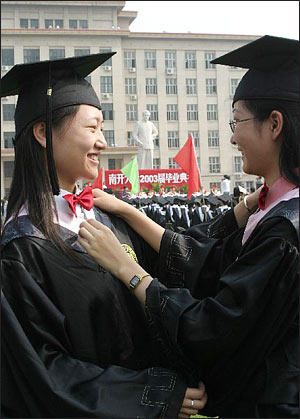By the end of 2005, China had 2,273 institutions of higher learning with over 21 million students. Postgraduate education is growing fast, with 979,000 full-time postgraduate students in 2005, a 20 percent increase on the 2001 figure. The gross enrollment rate of 21 percent in higher education indicates that China has entered the stage of popular education. The UNESCO world higher education report of June 2003 pointed out that the student population of China's schools of higher learning had doubled in a very short period, and was the world's largest.
 |
The higher education system has been improved in recent reforms. Many industrial polytechnic and specialized colleges have been established, strengthening some incomplete subjects and establishing new specialties, e.g., automation, atomic energy, energy resources, oceanography, nuclear physics, computer science, polymer chemistry, polymer physics, radiochemistry, physical chemistry and biophysics. A project for creating 100 world-class universities began in 1993, which has merged 708 schools of higher learning into 302 universities. This process has produced far-reaching reform of higher education management, optimizing educational resource allocation, and further improving teaching quality and school standards. More than 30 universities have received help from a special state fund to support their attainment of world elite class.
Between 1999 and 2003, enrollment in higher education increased from 1.6 million to 3.82 million. In 2005, the total enrollment in ordinary schools of higher learning and vocational schools was 4.75 million, 280,000 more than the previous year. Schools of higher learning and research institutes enrolled 370,000 postgraduate students, 44,000 more than the previous year.
The contribution made by scientific research in the higher education sector to China's economic construction and social development is becoming ever more evident. By strengthening cooperation between their production, teaching and research, schools of higher learning are speeding up the transformation of research results into products, giving rise to many new and hi-tech enterprises and important innovations. Forty-three national university sci-tech parks have been approved or started, some of which have become important bases for turning research into products.

